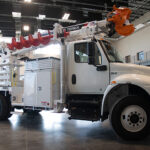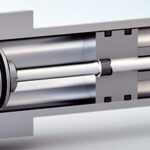Learn how hydraulics are used in maritime vessels and why hydraulics is the technology of choice.
By Josh Cosford, Contributing Editor

Hydraulics have played a vital role in various industries, and the marine sector is no exception. From small pleasure boats to large ocean liners, hydraulics are extensively used in a wide range of marine applications because of their compact, robust nature. Let’s explore the applications of hydraulics in marine settings, delve into the common hydraulic components used, and discuss why hydraulics are particularly suitable for marine vessels.
Steering
Hydraulic systems are the backbone of steering mechanisms on boats and watercraft. These hydraulic steering systems employ one of the few manually operated hydraulic pumps outside reciprocating handpumps. By using hydraulic power, these systems offer precise control and maneuverability, even in challenging conditions. Hydraulic steering systems can transmit high forces, allowing for effortless and responsive navigation, where hydraulic power easily transmits to turn the rudder, ensuring smooth and reliable steering, regardless of the vessel’s size.
Sailboats, for example, employ helm pumps constructed similarly to a gerotor motor but instead pump when their shafts are turned. These bi-rotational pumps work in a closed circuit attached to a hydraulic cylinder mounted to the rudder.
Hydraulic steering applications highlight a foundational concept of theoretical hydraulics — mechanical advantage. The double-rod cylinder on the rudder ensures linear steering in both directions because displacement is equal. Turning the helm pumps equal fluid into either rod volume of the cylinder, and force multiplication occurs at a given ratio despite knowledge of the forces involved.
For example, let’s assume the volume of our steering cylinder (which tends to be small because of the high power density of hydraulics) is 20 in.3. If we install a helm pump with one cubic inch displacement, we immediately see that our helm requires twenty complete rotations to stroke our steering cylinder fully. Unless you enjoy sailing in tight circles, the rudder is positioned in the middle, leaving only 10 in.3 from the steering cylinder piston. Ten helm rotations in either direction of the center provide a hard-over rudder position.
Suppose we now observe the ratio of the cylinder (20 in.3) to the helm pump (1 in.3). In that case, we quickly calculate the volume ratio at 20:1. What’s fun about hydraulics is that volume ratios are the same as force ratios. This means that for every pound of force applied to the helm pump, you can expect twenty pounds of force at the steering cylinder. Considering the pump is rotated via the helm, which is often greater than 12 in. in diameter, you can also expect high input force.
Anchoring
Hydraulic systems are also employed in anchor handling and winch mechanisms to manage heavy loads efficiently. Hydraulic winches deploy and retrieve anchors, hoist heavy equipment, and handle towing operations despite sometimes brutal operating conditions. The versatility and reliability of hydraulic systems make them ideal for handling various marine applications that require controlled power and precise control.
Hydraulic winches for ships showcase some of the largest hydraulic motors currently produced. With displacement easily topping 3,000 in.3 per rotation, the largest winch systems offer hundreds of thousands of pounds of line pull for applications such as barge handling, escort service, and docking.
Lifting and lowering
Marine environments typically require moving and positioning heavy loads, so hydraulic systems are extensively used in cranes and lifts aboard ships and vessels. These systems provide the power needed to lift and lower cargo, offering a high degree of control and safety. Additionally, hydraulic systems can be designed to withstand harsh marine conditions, such as corrosive saltwater and extreme temperatures, ensuring reliable and durable operation.

Commercial ships don’t always have boarding doors on the side of their hull, so supplies must be boarded via the gangway or a crane that lifts the supplies off the dock and onto the deck. These are often extendable jib cranes that can lift a few thousand pounds of supplies. A hydraulic cylinder operates the boom, while rotary actuators rotate the crane assembly for precise placement.
Vessel stability
Stability is crucial for marine vessels, especially during adverse weather conditions. Hydraulic stabilizer systems help counteract the rolling motion of a boat, enhancing comfort and safety on board. By using hydraulic actuators, these systems provide instant response and quick adjustments to maintain vessel stability. Hydraulic stabilizers are particularly beneficial in reducing the risk of seasickness and ensuring the well-being of passengers and crew.
Stabilizers work by pivoting a fin mounted on each side of the hull, which can respond quickly to counteract waves and wind, keeping the vessel true. Advanced modern systems have sophisticated hydraulic power units to electronically monitor position and adjust the stabilizers quickly to counteract motion.
Hydraulic components used in marine vessels
Hydraulic pumps are the heart of any hydraulic system, as they convert mechanical power into hydraulic energy by pressurizing fluid, typically hydraulic oil. In marine applications, pumps are commonly driven by electric motors or engines and come in various types, including gear, vane, and piston designs. The choice of pump depends on the application’s specific requirements and budget.
Cylinders and actuators are crucial components that convert hydraulic energy into mechanical force or motion. In marine applications, hydraulic cylinders are used for steering, lifting, and stabilizing tasks. These devices include a cylinder barrel, piston, rod, heads/caps, and seals. When directed to do so, pressurized fluid enters the cylinder, pushing the piston to generate linear force or motion. Hydraulic motors are much like pumps, except they convert incoming hydraulic energy into mechanical torque at their output. Cylinders or motors produce force proportional to their size, although inversely to speed.
Hydraulic valves are responsible for directing the flow of hydraulic fluid and regulating pressure in a hydraulic system. They are used in steering systems, winches, and other marine applications to control hydraulic actuators’ direction, speed, and force. Valves enable precise and instantaneous adjustments, allowing operators to navigate vessels smoothly and handle loads accurately.

Hydraulic systems require suitable hydraulic fluid to transfer power effectively and lubricate internal components. Marine hydraulic systems commonly use mineral-based hydraulic fluids with excellent stability, corrosion resistance, and low-temperature performance. However, in many cases, marine fluid must now be biodegradable in case of an accidental spill, and any responsible captain only uses oils that meet the EPA’s toxicity requirements for marine life.
Additionally, hydraulic filters are employed to remove contaminants and maintain the hydraulic fluid’s cleanliness, ensuring the system’s longevity and efficiency. Contamination is the number one cause of failure in hydraulic systems, and when contamination is high, wear particles exacerbate the wear of other components. Nobody wants to be stuck out at sea without steering, so fluid cleanliness practices are always a number-one priority.
It should be said that hydraulic components work best when they’re free from corrosion, so where budget permits, avoid components with materials such as aluminum and carbon steel. Materials such as stainless steel or brass are preferred, as they’re better able to resist the corrosive effects of salt water.
Why hydraulics benefit marine applications
Hydraulic systems provide a high power-to-weight ratio, making them ideal for marine applications with limited weight and space. Hydraulic components’ compact design and high power density allow efficient power transmission without compromising vessel performance. Hydraulic systems offer precise control and responsiveness, enabling operators to handle marine operations accurately. The ability to vary force and speed, combined with instantaneous response, makes hydraulics highly suitable for steering, lifting, and stabilizing tasks, ensuring the safety and comfort of the vessel and its occupants.
Marine environments pose unique challenges due to exposure to saltwater, humidity, and extreme temperatures. Hydraulic systems can be designed with corrosion-resistant materials, seals, and coatings to withstand these harsh conditions, ensuring long-term reliability and minimizing maintenance requirements.
Marine hydraulic systems can also incorporate safety features, such as pressure relief valves and fail-safe mechanisms, to prevent overloading and ensure safe operation. Additionally, redundant hydraulic systems can be implemented to provide backup and redundancy, minimizing the risk of system failure and enhancing safety in critical marine applications. For example, if your trim adjustment uses a dc-powered compact hydraulic power unit, the handpump option to manually adjust the trim could be a lifesaver should the power unit’s motor fail.
Hydraulics have revolutionized marine applications, providing efficient and reliable power transmission for various tasks on boats and watercraft, from steering systems to cargo handling and stabilization; hydraulics offers robust, precise control, durability, and high power density. Using hydraulic technology, marine vessels can navigate the open seas with enhanced efficiency, safety, and maneuverability, making hydraulics an indispensable component of modern maritime operations.






